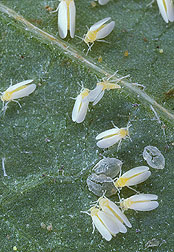Whiteflies May Meet Their Match in the Form of New Fungus
|
|
Whiteflies are very, very tiny. Under a magnifying glass, they resemble moths—but from afar they look like wispy snowflakes.
While whiteflies may be small in stature, they can be deadly as a pest. They suck and feed on the juices of hundreds of host plants—crops, ornamentals, and weeds. Heavy feeding can give plants a yellow, mottled look and eventually kill them.
Whiteflies cause major crop losses, both directly by feeding, and indirectly by transmitting plant viruses. Use of pesticides to control them is unsatisfactory because of their built-in natural resistance, the need for repeated applications, and the potential hazard some insecticides may pose to other living things or to the environment.
Fortunately, ARS scientists, led by Enrique Cabanillas, an entomologist in the Beneficial Insects Research Unit (BIRU), at Weslaco, Texas, may be on the verge of a major biological control breakthrough. Working under the supervision of Walker Jones, entomologist and former research leader of BIRU, Cabanillas has discovered a promising anti-whitefly fungus.
Isolated by Cabanillas in 2001 from infected whiteflies feeding on eggplants, the fungus kills both larvae and adults of the silverleaf whitefly, Bemisia argentifolii. Since 2001, it has periodically wiped out whiteflies at the ARS insect-rearing facilities in Weslaco. This new fungal species, Isaria poprawskii, was named in memory of the late Tadeusz Poprawski, a former BIRU scientist known worldwide for his work on insect pathology for microbial control of crop pests. He worked on whiteflies and other target hosts in the region.
Detailed morphological, molecular, pathological, and ecological studies have shown this fungus to be an entomopathogenic species—that is, one that can parasitize insects and then kill or disable them. This work was done by Cabanillas; Jones, currently director of the European Biological Control Laboratory at Montpellier, France; microbiologist Richard Humber of the Plant Protection Research Unit at Ithaca, New York; molecular biologist Jesse de León of BIRU; and molecular biologist Dan Murray of the Honey Bee Research Unit at Weslaco.
Further studies conducted by Cabanillas and Jones indicate that I. poprawskii also harms larvae and adults of the glassy-winged sharpshooter, Homalodisca vitripennis, the main vector of the bacterium that causes Pierce’s disease, which is destroying grapevines in parts of California.
In addition to its potential to fight two major insect pests, other remarkable features of this fungus include its natural establishment in a semiarid region where temperatures reach 107˚F; its persistence even in the absence of insect hosts; and its high spore production in common culture media, which makes it comparatively easy to grow in the laboratory. These features suggest that the fungus could be a promising candidate for practical biological control of the silverleaf whitefly and the glassy-winged sharpshooter.—By Alfredo Flores, Agricultural Research Service Information Staff.
This research is part of Crop Protection and Quarantine, an ARS National Program (#304) described on the World Wide Web at www.nps.ars.usda.gov.
H. Enrique Cabanillas is in the USDA-ARS Beneficial Insects Research Unit, Kika de la Garza Subtropical Agricultural Research Center, 2413 E. Highway 83, Weslaco, TX 78596; phone (956) 969-4861, fax (956) 969-4888.
"Whiteflies May Meet Their Match in the Form of New Fungus" was published in the May/June 2007 issue of Agricultural Research magazine.







